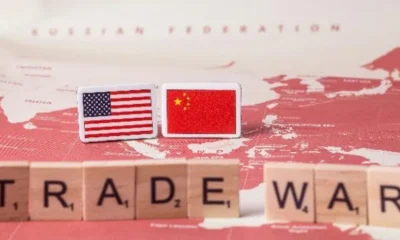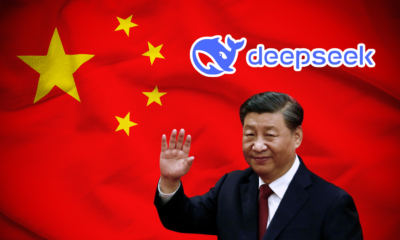Published
9 months agoon

ArcelorMittal South Africa Ltd., the continent’s largest steelmaker, has announced the closure of its long-steel business, a move that could jeopardize 3,500 jobs and deal a significant blow to South Africa’s struggling industrial sector.
This decision, initially declared in February but postponed following consultations with the government and state-owned freight firms, shows the mounting pressures on the local steel industry, due to China’s growing steel dominance.
South Africa’s Steel Industry Under Siege
ArcelorMittal South Africa cited a combination of deteriorating global and local steel markets, surging low-cost imports—primarily from China—and persistently high logistics and energy costs as key reasons for the shutdown. The lak of sufficient policy intervention by the South African government has also left the business unsustainable, the company said in a statement.
The closure will impact operations at Newcastle and Vereeniging Works, along with the rail and structures unit Amras. While a scaled-back coke-making operation at Newcastle will continue to meet reduced demand, steel production is expected to cease entirely by the end of the month. The exact number of job losses remains uncertain.

China’s Steel Prowess. A Global Challenge
The challenges facing South Africa’s steel industry are part of a broader global trend driven by China’s relentless steel exports. As the world’s largest steel producer, China has been exporting steel at near-decade high volumes to manage domestic overcapacity and sluggish local demand, particularly due to its weakened property sector.
In 2023, Chinese steel exports surged 21.2% year-on-year to 80.71 million tons in the first three quarters, putting the country on track to export over 100 million tons by the year’s end—the highest since 2016. With competitive pricing and rising demand from regions such as Southeast Asia, the Middle East, North Africa, and India, Chinese steel exports are projected to remain robust in 2025, potentially reaching 90–100 million tons.
Leading Chinese steelmakers, including Baoshan Iron & Steel Co., have ramped up their export targets, with Baoshan achieving a record 5.84 million tons in 2023 and aiming for over 10 million tons annually by 2028. Analysts warn that China’s low-cost steel and its aggressive export strategy will continue to challenge global competitors and fuel trade frictions.
Global Steel Demand But Trade Tensions Persist
The World Steel Association has projected a 1.2% rebound in global steel demand to 1.77 billion tons in 2025, marking a recovery after three consecutive years of decline. However, this optimism is clouded by intensifying trade tensions fueled by China’s surging steel exports, which continue to dominate global markets.
China’s aggressive steel export strategy has sparked complaints from an increasing number of countries. Nations such as Turkey and Indonesia have imposed anti-dumping duties, arguing that an influx of low-cost Chinese steel undermines local manufacturers.
This year alone, 28 trade remedy cases have been filed against Chinese steel products, a sharp rise compared to just eight cases over the past three years, according to data from the state-backed China Trade Remedies Information.
This growing trend of trade disputes is unlikely to subside. Analysts, including Wood Mackenzie’s Lawrence Zhang, predict that complaints will intensify in 2025 as Chinese exports continue to challenge global trade dynamics.
China’s Position Amid Trade Frictions
Responding to trade tensions, a spokesperson for Chinese customs stated recently that most Chinese steel products are intended to meet domestic demand. However, the spokesperson also said that innovations in the steel industry are enhancing the appeal of Chinese products in international markets.
Despite these assurances, official data reveals a 3.6% decline in China’s steel output during the first three quarters of the year, reflecting weakened domestic demand. The World Steel Association forecasts that China’s steel demand will drop by 3% in 2024 and another 1% in 2025. This persistent oversupply creates significant pressure to push surplus production into export markets.

Export Markets and Challenges
While Chinese steelmakers and trade groups acknowledge that trade frictions and a strengthening yuan may pose challenges, analysts expect China’s export prices to remain highly competitive. Customs data shows that the primary destinations for Chinese steel are Southeast Asia, the Middle East, and South America, with less than 1% of exports directed to the U.S.
Despite this fragmentation of export markets, U.S.-China trade tensions remain prominent. In April, President Joe Biden advocated for higher tariffs on Chinese metal products, emphasizing the need to protect key industries like electric vehicles and solar power.
One potential disruptor to China’s steel export momentum is Vietnam’s anti-dumping investigation into hot-rolled coil, a product that constitutes a significant portion of China’s exports. Tomas Gutierrez, head of data at Kallanish Commodities, noted that this probe could be highly disruptive but emphasized that Chinese exporters are adept at finding price levels that enable continued exports.
The Role of Tax Evasion in Exports
A key risk to China’s steel export strategy lies in domestic regulatory enforcement. Analysts estimate that approximately one-third of China’s steel exports last year—totaling 90.26 million tons—were facilitated through the evasion of value-added tax (VAT). A crackdown by Beijing on such practices could significantly impact export volumes, adding uncertainty to China’s steel trade outlook.
Outlook for 2025
As global steel demand shows signs of recovery, China’s export strategy will remain a focal point in international trade dynamics. While competitive pricing and rising demand in emerging markets may sustain China’s export momentum, mounting trade tensions and potential regulatory crackdowns could create headwinds for the world’s largest steel producer.


Taiwan’s ‘Historic’ TSMC Deal, A Win Or The End Of Its ‘Silicon Shield’ As China Threatens? A Jittery Taiwan Watches Trump’s Moves On Ukraine, Wondering, Could We Be Next?


A Trade War That Just Won’t Quit. As Trump’s Tariffs Hit, China Stays The Course, For Xi’s Its Business As Usual Strategy


Indian Stock Market In Turmoil. Investors In Panic Mode, Is This A Temporary Correction Or The Start Of A Bear Market?


America And China’s Thirst For Gold In 2025 Is Draining Other Countries’ Reserves; Here’s Why?


Shakeup In The Auto Sector. Mercedes-Benz 15% Job Cuts, Nissan CEO Exit, And Germany’s Make-Or-Break Year


DeepSeek Ai Rush. China’s AI Contender Gears Up for Next Big Launch Even As It Gets Xi Jinping’s Blessings
